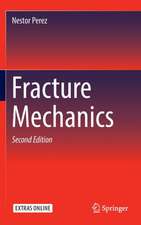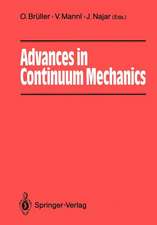Disorder and Fracture: NATO Science Series B:, cartea 235
Editat de J.C. Charmet, E. Guyon, Stéphane Rouxen Limba Engleză Paperback – 31 ian 1991
Din seria NATO Science Series B:
- 5%
 Preț: 375.70 lei
Preț: 375.70 lei - 5%
 Preț: 369.29 lei
Preț: 369.29 lei - 5%
 Preț: 720.84 lei
Preț: 720.84 lei - 18%
 Preț: 1406.03 lei
Preț: 1406.03 lei - 5%
 Preț: 373.33 lei
Preț: 373.33 lei - 5%
 Preț: 723.78 lei
Preț: 723.78 lei -
 Preț: 391.79 lei
Preț: 391.79 lei - 5%
 Preț: 1445.00 lei
Preț: 1445.00 lei - 5%
 Preț: 380.61 lei
Preț: 380.61 lei - 5%
 Preț: 1103.75 lei
Preț: 1103.75 lei - 5%
 Preț: 711.72 lei
Preț: 711.72 lei - 5%
 Preț: 1414.08 lei
Preț: 1414.08 lei - 18%
 Preț: 957.44 lei
Preț: 957.44 lei - 5%
 Preț: 723.21 lei
Preț: 723.21 lei - 5%
 Preț: 727.44 lei
Preț: 727.44 lei - 5%
 Preț: 1117.46 lei
Preț: 1117.46 lei - 5%
 Preț: 1423.55 lei
Preț: 1423.55 lei - 5%
 Preț: 366.56 lei
Preț: 366.56 lei - 5%
 Preț: 1116.21 lei
Preț: 1116.21 lei - 5%
 Preț: 1106.33 lei
Preț: 1106.33 lei - 5%
 Preț: 1107.77 lei
Preț: 1107.77 lei - 5%
 Preț: 1098.48 lei
Preț: 1098.48 lei - 5%
 Preț: 715.71 lei
Preț: 715.71 lei - 5%
 Preț: 1428.71 lei
Preț: 1428.71 lei - 5%
 Preț: 2004.54 lei
Preț: 2004.54 lei - 5%
 Preț: 724.70 lei
Preț: 724.70 lei - 5%
 Preț: 1438.38 lei
Preț: 1438.38 lei - 5%
 Preț: 1109.23 lei
Preț: 1109.23 lei - 5%
 Preț: 1414.64 lei
Preț: 1414.64 lei - 5%
 Preț: 1284.75 lei
Preț: 1284.75 lei - 5%
 Preț: 1023.26 lei
Preț: 1023.26 lei - 5%
 Preț: 388.12 lei
Preț: 388.12 lei - 5%
 Preț: 1104.48 lei
Preț: 1104.48 lei -
 Preț: 383.93 lei
Preț: 383.93 lei - 5%
 Preț: 718.46 lei
Preț: 718.46 lei - 5%
 Preț: 1113.63 lei
Preț: 1113.63 lei - 5%
 Preț: 369.45 lei
Preț: 369.45 lei - 5%
 Preț: 1108.72 lei
Preț: 1108.72 lei - 5%
 Preț: 1107.77 lei
Preț: 1107.77 lei - 5%
 Preț: 1297.99 lei
Preț: 1297.99 lei - 5%
 Preț: 1123.87 lei
Preț: 1123.87 lei - 5%
 Preț: 718.65 lei
Preț: 718.65 lei - 5%
 Preț: 2011.46 lei
Preț: 2011.46 lei - 5%
 Preț: 721.40 lei
Preț: 721.40 lei
Preț: 645.47 lei
Preț vechi: 759.37 lei
-15% Nou
Puncte Express: 968
Preț estimativ în valută:
123.55€ • 134.25$ • 103.85£
123.55€ • 134.25$ • 103.85£
Carte tipărită la comandă
Livrare economică 21 aprilie-05 mai
Preluare comenzi: 021 569.72.76
Specificații
ISBN-13: 9780306435768
ISBN-10: 0306435764
Pagini: 316
Ilustrații: 316 p.
Dimensiuni: 178 x 254 x 17 mm
Greutate: 0.56 kg
Ediția:Softcover reprint of the original 1st ed. 1990
Editura: Springer Us
Colecția Springer
Seria NATO Science Series B:
Locul publicării:New York, NY, United States
ISBN-10: 0306435764
Pagini: 316
Ilustrații: 316 p.
Dimensiuni: 178 x 254 x 17 mm
Greutate: 0.56 kg
Ediția:Softcover reprint of the original 1st ed. 1990
Editura: Springer Us
Colecția Springer
Seria NATO Science Series B:
Locul publicării:New York, NY, United States
Public țintă
ResearchCuprins
I. Tools.- 1 Fluctuations of Interfaces and Fronts.- 2 Introduction to Multifractality.- 3 Statistical Theory of Fragmentation.- II. Diffusion-Limited Aggregation Model.- 4 Theory and Simulation of Diffusion-Limited Growth.- 5 Growth Patterns and Fronts: Fluid Flow Experiments.- 6.1 From Flow to Fracture and Fragmentation in Colloidal Media 1: Non-Newtonian Fingering and Visco-Elastic Fracturing.- 6.2 From Flow to Fracture and Fragmentation in Colloidal Media 2: Local Order and Fragmentation Geometry.- III. Statistical Fracture Models.- 7 Simple Stochastic Models for Material Failure.- 8 Scaling Theory of the Strength of Percolation Networks.- 9 Scaling in Fracture.- IV. Rheology and Fracture.- 10 Micromechanics of Brittle Deformation Processes.- 11 Fracture Mechanics and Solid Adhesion.- 12 Damage Evolution, Instability and Fracture in Ductile Solids.- 13 Aspects of Nonlinearity and Self organisation in Plastic Deformation.- V. Materials and Applications.- 14 Granular Media: Effects of Disorder.- 15 Cracking and Fracture of Concrete: Size Effect or Scaling Law?.- 16.1 The Phenomenology of Earthquake Occurrence.- 16.2 The Modeling of Earthquake Occurrence.

















